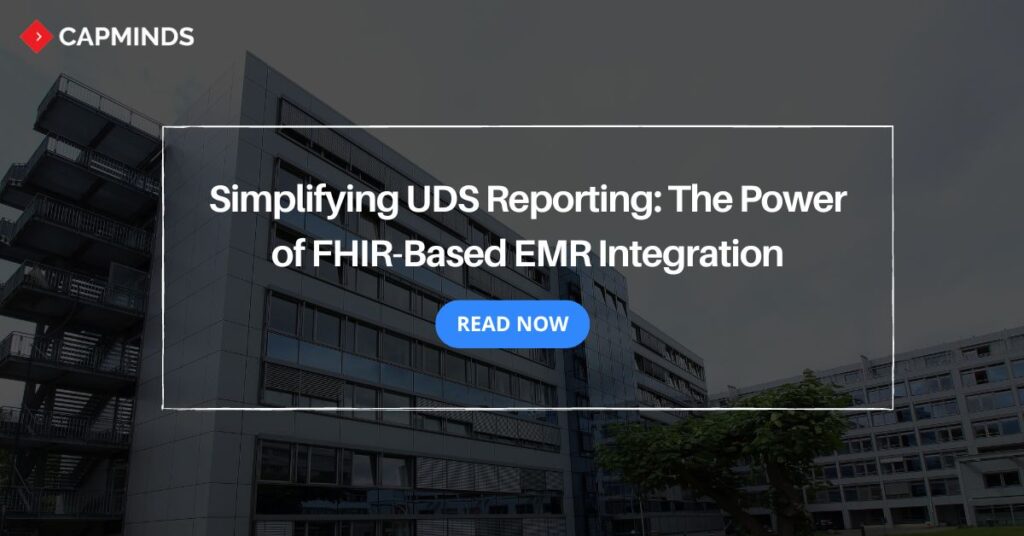Simplifying UDS Reporting: The Power of FHIR-Based EMR Integration
The Uniform Data System (UDS) is a standardized reporting system used by federally qualified health centers (FQHCs) and look-alike organizations to report on their performance and operations to the Health Resources and Services Administration (HRSA).
Traditionally, generating UDS reports has been manual and time-consuming, involving extracting data from various sources, cleaning, and manual entry into the UDS reporting system.
However, with the advent of electronic medical records (EMRs) and the increasing adoption of interoperability standards like Fast Healthcare Interoperability Resources (FHIR), the process of UDS reporting can be streamlined and automated.
FHIR is a modern, open standard for exchanging healthcare data, developed by Health Level Seven International (HL7). It provides a standardized way for different healthcare systems to communicate and share data, enabling seamless integration and data exchange.
By leveraging FHIR, EMRs can establish electronic integration with the UDS reporting system, enabling the automatic extraction and submission of relevant data. This integration eliminates the need for manual data entry, reduces the risk of errors, and improves the overall efficiency and accuracy of the UDS reporting process.
Related: A Complete Guide To FHIR Resources & FHIR API
Here’s a high-level overview of how electronic integration between EMRs and the UDS reporting system using FHIR can work:
- Data Mapping: The first step is to map the data elements required for UDS reporting to the corresponding FHIR resources and fields within the EMR system. This mapping ensures that the EMR data is properly structured and aligned with the UDS reporting requirements.
- FHIR API Integration: The EMR system exposes an FHIR API that allows authorized systems, like the UDS reporting system, to securely access and retrieve relevant patient data. The FHIR API follows standardized protocols and data formats, enabling seamless communication between the systems.
- Data Extraction and Transformation: Through the FHIR API, the UDS reporting system can query the EMR system for the required data elements. The retrieved data is then transformed and mapped to the appropriate UDS reporting format.
- Automated Submission: Once the data is properly formatted, the UDS reporting system can automatically submit the required reports to HRSA, eliminating the need for manual data entry and submission.
- Monitoring and Auditing: The integration process can be monitored and audited to ensure data integrity, compliance, and timely submission of UDS reports.
By leveraging FHIR and electronic integration, FQHCs and look-alike organizations can streamline their UDS reporting processes, reduce administrative burdens, and improve data quality and accuracy.
UDS Reporting Module in OpenEMR
OpenEMR, a popular open-source EMR system, offers a dedicated UDS reporting module that facilitates the generation of UDS reports. This module takes advantage of the FHIR integration capabilities within OpenEMR, enabling seamless data extraction and reporting.
Here’s a glimpse of how the UDS reporting module in OpenEMR works:
- Data Mapping and Extraction: The UDS reporting module maps the required data elements to the corresponding FHIR resources and fields within OpenEMR. It then extracts the relevant data from the EMR system using FHIR APIs.
- Reporting Templates: OpenEMR provides pre-defined reporting templates that align with the UDS reporting requirements. These templates ensure that the extracted data is properly formatted and organized for submission.
- Data Validation: The module includes built-in data validation mechanisms to ensure the integrity and completeness of the extracted data before generating the final UDS reports.
- Report Generation: Once the data is validated, the UDS reporting module generates the required reports in the specified format, such as CSV or XML files.
- Submission and Auditing: OpenEMR provides functionality to securely submit the generated UDS reports to HRSA. It also offers audit trails and logging capabilities to monitor the submission process and ensure compliance.
Here’s an example code snippet that demonstrates how OpenEMR leverages FHIR APIs to extract patient data for UDS reporting:
PHP
// Connect to the OpenEMR FHIR server
$fhirClient = new FHIRClient('https://example.com/openemrthir/fhir/');
// Search for patients with specific criteria (e.g., age, gender, diagnosis)
$patientQuery = new PatientSearchQuery();
$patientQuery->addFilter('gender', 'male');
$patientQuery->addFilter('birthdate', '>=1990-01-01');
$patients = $fhirClient->search($patientQuery);
// Iterate through the patients and extract relevant data
foreach ($patients as $patient) {
$patientId = $patient->getId();
$gender = $patient->getGender();
$birthDate = $patient->getBirthDate();
// Extract other relevant data using FHIR resources (e.g., Condition, Observation, Encounter)
$conditions = $fhirClient->searchConditions($patientId);
$observations = $fhirClient->searchObservations($patientId);
$encounters = $fhirClient->searchEncounters($patientId);
// Process and map the extracted data to UDS reporting format
$udsData = mapToUDSFormat($gender, $birthDate, $conditions, $observations, $encounters);
// Add the processed data to the UDS report
$udsReport->addPatientData($udsData);
}
// Generate and submit the UDS report
$udsReport->generate();
$udsReport->submit();This code snippet demonstrates how OpenEMR can leverage FHIR APIs to extract patient data, such as gender, birth date, conditions, observations, and encounters. The extracted data is then mapped to the UDS reporting format and added to the UDS report. Finally, the report is generated and submitted.
Related: University Of Maryland: A Telehealth Grant Program Success Story
Frequently Asked Questions (FAQs)
- What is FHIR, and why is it important for UDS reporting?
FHIR (Fast Healthcare Interoperability Resources) is a modern, open standard for exchanging healthcare data. It provides a standardized way for different healthcare systems to communicate and share data, enabling seamless integration and data exchange.
FHIR is crucial for UDS reporting because it allows EMRs to electronically integrate with the UDS reporting system, automating the data extraction and submission process.
- How does electronic integration using FHIR benefit UDS reporting
Electronic integration using FHIR streamlines the UDS reporting process by eliminating manual data entry, reducing the risk of errors, and improving overall efficiency and accuracy. It enables automated data extraction, transformation, and submission, saving time and resources for healthcare organizations.
- What are the key steps involved in integrating EMRs with the UDS reporting system using FHIR?
The key steps include data mapping, FHIR API integration, data extraction and transformation, automated submission, and monitoring and auditing.
- How does the UDS reporting module in OpenEMR work?
The UDS reporting module in OpenEMR maps the required data elements to FHIR resources, extracts relevant data using FHIR APIs, formats the data according to UDS reporting templates, validates the data, generates reports, and facilitates secure submission to HRSA.
- Can you provide an example of how OpenEMR leverages FHIR APIs for UDS reporting?
Certainly! The code snippet provided demonstrates how OpenEMR can use FHIR APIs to extract patient data, such as gender, birth date, conditions, observations, and encounters, and then map the extracted data to the UDS reporting format for generating and submitting the report.
Other Updates:
- The Office of the National Coordinator for Health Information Technology (ONC) has recently released updated guidance on the use of FHIR for electronic health data exchange, highlighting its importance in improving interoperability and data sharing across healthcare systems.
- Several major EMR vendors, including Epic, Cerner, and Allscripts, have announced enhanced FHIR support and integration capabilities in their latest software releases, enabling seamless data exchange and improving interoperability with other healthcare systems.
- The Centers for Medicare & Medicaid Services (CMS) has proposed new rules that would require healthcare providers to adopt FHIR-based APIs for patient data access, further emphasizing the importance of FHIR in healthcare data exchange.
- HL7, the organization responsible for developing and maintaining FHIR standards, has released FHIR Release 5, including improvements in security, scalability, and support for advanced use cases.
Optimize Your UDS Reporting with CapMinds
At CapMinds, we specialize in FHIR-based EMR integration solutions for streamlining UDS reporting. Our team of healthcare IT experts has extensive experience in integrating EMRs with the UDS system, ensuring seamless data extraction, transformation, and submission.
Partner with us and experience the power of FHIR-based integration, enabling you to automate your UDS reporting processes, reduce administrative burdens, and improve data accuracy.
Contact us today to schedule a free consultation and learn how our solutions can transform your reporting workflows, keeping you compliant and ahead of the curve.

